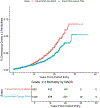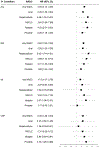Burden of Chronic Health Conditions Among People With HIV and Common Non-AIDS-Defining Cancers
- PMID: 40490015
- PMCID: PMC12309724
- DOI: 10.6004/jnccn.2025.7018
Burden of Chronic Health Conditions Among People With HIV and Common Non-AIDS-Defining Cancers
Abstract
Background: With advances in antiretroviral therapy, aging people with HIV (PWH) are increasingly at risk for non-AIDS-defining cancers (NADCs) and chronic morbidities. This study examines whether PWH with NADCs face a higher risk of new-onset chronic health conditions compared with those without cancer.
Patients and methods: We conducted a retrospective cohort study using data from the CFAR (Centers for AIDS Research) Network of Integrated Clinical Systems (CNICS) for PWH enrolled between 1995 and 2018 from 8 US academic institutions. We included PWH with the 5 most common NADCs: anal cancer, non-small cell lung cancer (NSCLC), prostate cancer, classic Hodgkin lymphoma (HL), and hepatocellular carcinoma (HCC). A 1:2 matching for each NADC subgroup was performed based on age, cohort entry year, and sex (noncancer cohort). Chronic health conditions were graded using the CTCAE, with the primary outcome being the risk of new-onset grade ≥3 morbidities, analyzed using Cox regression.
Results: The study included 693 PWH with NADCs and 1,345 matched PWH without cancer. At a median follow-up of 13.7 years for PWH with NADCs and 10.7 years for the noncancer group, the prevalence of grade ≥3 morbidities was significantly higher in the NADC group (24.8% vs 13.8%; P≤.01). Multivariable Cox regression showed a higher risk of new-onset grade ≥3 conditions in the NADC group (hazard ratio, 2.94; P<.0001), specifically diabetes mellitus (all NADCs), myocardial infarction (NSCLC and HL), and congestive heart failure (prostate cancer).
Conclusions: Our study showed an excess risk of new-onset morbidities among PWH with NADCs. These findings have critical implications for the care of survivors of HIV and cancer and underscore the importance of integrated care approaches to address late effects in this vulnerable population.
Conflict of interest statement
Authors' Disclosures of Potential Conflicts of Interest
G.G. has served on advisory board for Opna Bio, Seagen, Electra, and Sobi, and received consulting fee from Recordati.
Figures




References
-
- Lohse N, Obel N. Update of Survival for Persons With HIV Infection in Denmark. Ann Intern Med. 2016;165(10):749–750. - PubMed
-
- CDC. Diagnoses of HIV infection in the United States and dependent areas, 2019. HIV Surveillance Report. 2021; 32.
-
- Grulich AE, van Leeuwen MT, Falster MO, Vajdic CM. Incidence of cancers in people with HIV/AIDS compared with immunosuppressed transplant recipients: a meta-analysis. Lancet. 2007;370(9581):59–67. - PubMed
MeSH terms
Grants and funding
LinkOut - more resources
Full Text Sources
Medical

